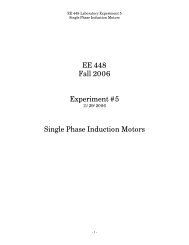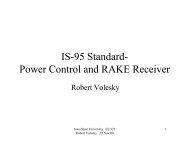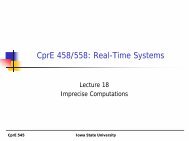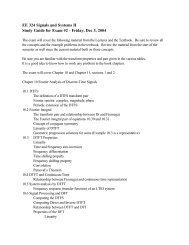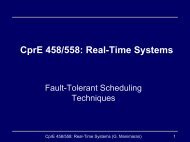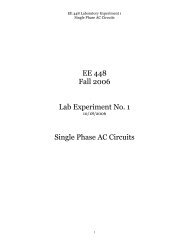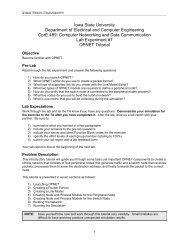Lab Experiment No. 4: Introduction to the Principle of Superposition
Lab Experiment No. 4: Introduction to the Principle of Superposition
Lab Experiment No. 4: Introduction to the Principle of Superposition
Create successful ePaper yourself
Turn your PDF publications into a flip-book with our unique Google optimized e-Paper software.
EE 442 <strong>Lab</strong>ora<strong>to</strong>ry <strong>Experiment</strong> 4<strong>Introduction</strong> <strong>to</strong> <strong>the</strong> <strong>Principle</strong> <strong>of</strong> <strong>Superposition</strong>EE 442Fall 2006<strong>Lab</strong> <strong>Experiment</strong> <strong>No</strong>. 49/6/2006<strong>Introduction</strong> <strong>to</strong> <strong>the</strong> <strong>Principle</strong> <strong>of</strong><strong>Superposition</strong>1
EE 442 <strong>Lab</strong>ora<strong>to</strong>ry <strong>Experiment</strong> 4<strong>Introduction</strong> <strong>to</strong> <strong>the</strong> <strong>Principle</strong> <strong>of</strong> <strong>Superposition</strong>2, for i 1 ’, i 2 ’, and i 3 ’, and record your results in <strong>the</strong> spaces provided(in Figure 2).R14.7k12VdcV1R2i1'10ki3'R3i2'33kFigure 2 Circuit in Figure 1 with <strong>the</strong> lower source suppressedI 1 ’ = __________I 2 ’ = __________I 3 ’ = __________C. Suppress <strong>the</strong> upper voltage source in <strong>the</strong> circuit <strong>of</strong> Figure 1 byreplacing it with a short circuit. Solve <strong>the</strong> resulting circuit, shownin Figure 3, for i 1 ’’, i 2 ’’, i 3 ’’, and record your results in <strong>the</strong> spacesprovided.3
EE 442 <strong>Lab</strong>ora<strong>to</strong>ry <strong>Experiment</strong> 4<strong>Introduction</strong> <strong>to</strong> <strong>the</strong> <strong>Principle</strong> <strong>of</strong> <strong>Superposition</strong>R14.7kR2i1''12VdcV2i3''10kR3i2''33kFigure 3 Circuit <strong>of</strong> Figure 1 with <strong>the</strong> upper source suppressedI 1 ’’ = __________I 2 ’’ = __________I 3 ’’ = __________D. Combine <strong>the</strong> solutions <strong>of</strong> parts B and C and compare with <strong>the</strong>solution <strong>of</strong> part A.III.LABORATORY EXERCISES1. Connect <strong>the</strong> circuit shown in Figure 4 using <strong>the</strong> Agilent E3630A.(Make sure <strong>the</strong> tracking ratio knob is locked in <strong>the</strong> Fixed position;this position will guarantee that both <strong>the</strong> +20 and -20 V taps deliver<strong>the</strong> same voltage magnitude with respect <strong>to</strong> <strong>the</strong> common tap.)4
EE 442 <strong>Lab</strong>ora<strong>to</strong>ry <strong>Experiment</strong> 4<strong>Introduction</strong> <strong>to</strong> <strong>the</strong> <strong>Principle</strong> <strong>of</strong> <strong>Superposition</strong>DC Supply+20 V tapAmmeterR1A14.7k12VdcV1CommonR210k12VdcV2-20 V tapAmmeterA2R333kFigure 4 <strong>Lab</strong>ora<strong>to</strong>ry version <strong>of</strong> <strong>the</strong> circuit in Figure 12. Energize <strong>the</strong> circuit <strong>of</strong> Figure 4 and <strong>the</strong>n measure and record <strong>the</strong>following data:a. Ammeter readings A 1 and A 2 (compare with preliminarycalculations)A 1 = __________A 2 = __________b. Voltage across <strong>the</strong> 4.7kΩ and 10kΩ resis<strong>to</strong>rsV 4.7 kΩ = __________V 10 kΩ = __________c. Voltage across <strong>the</strong> upper 12 Volt source terminalsV 12 V = __________3. Using <strong>the</strong> data obtained in Step 2, apply KVL by calculating <strong>the</strong> sum<strong>of</strong> all <strong>the</strong> voltage drops around <strong>the</strong> upper closed loop (remember <strong>to</strong>take <strong>the</strong> algebraic signs in<strong>to</strong> account). Is KVL satisfied?4. Turn <strong>of</strong>f <strong>the</strong> DC supply and reconnect <strong>the</strong> circuit as shown in Figure5.5
EE 442 <strong>Lab</strong>ora<strong>to</strong>ry <strong>Experiment</strong> 4<strong>Introduction</strong> <strong>to</strong> <strong>the</strong> <strong>Principle</strong> <strong>of</strong> <strong>Superposition</strong>DC Supply+20 V tapAmmeterR1A14.7k12VdcV1CommonR210k12VdcV2-20 V tapAmmeterA2R333kFigure 5 <strong>Lab</strong>ora<strong>to</strong>ry version <strong>of</strong> <strong>the</strong> circuit in Figure 25. <strong>No</strong>te that <strong>the</strong> circuit in Figure 5 is equivalent <strong>to</strong> replacing <strong>the</strong> lowervoltage source in Figure 4 with zero Ohms (short circuit). Do notconnect <strong>the</strong> -20 V tap directly <strong>to</strong> <strong>the</strong> common tap whensuppressing <strong>the</strong> lower supply.6. Energize <strong>the</strong> circuit in Figure 5 and <strong>the</strong> measure and record <strong>the</strong>following data:a. Ammeter readings A 1 and A 2 (compare with prelimcalculations)A 1 = __________A 2 = __________b. Voltage across <strong>the</strong> 10 kΩ resis<strong>to</strong>rV 10 kΩ = __________7. Turn <strong>of</strong>f <strong>the</strong> DC supply and rearrange <strong>the</strong> circuit according <strong>to</strong>Figure 6.6
EE 442 <strong>Lab</strong>ora<strong>to</strong>ry <strong>Experiment</strong> 4<strong>Introduction</strong> <strong>to</strong> <strong>the</strong> <strong>Principle</strong> <strong>of</strong> <strong>Superposition</strong>DC Supply+20 V tapAmmeterR1A14.7k12VdcV1CommonR210k12VdcV2-20 V tapAmmeterA2R333kFigure 6 <strong>Lab</strong>ora<strong>to</strong>ry version <strong>of</strong> <strong>the</strong> circuit in Figure 38. What does <strong>the</strong> circuit arrangement <strong>of</strong> Figure 6 accomplish in terms<strong>of</strong> <strong>the</strong> original circuit?9. Energize <strong>the</strong> circuit given in Figure 6 and <strong>the</strong>n measure and record<strong>the</strong> following data:a. Ammeter readings A 1 and A 2 (compare with prelimcalculations)A 1 = __________A 2 = __________b. Voltage across <strong>the</strong> 10 kΩ resis<strong>to</strong>rV 10 kΩ = __________10. Turn <strong>the</strong> DC supply <strong>of</strong>f, but before dismantling <strong>the</strong> circuit, applyKCL and <strong>the</strong> principle <strong>of</strong> superposition by making <strong>the</strong> followingcalculations:a. Add <strong>the</strong> component values <strong>of</strong> i 1 measured in step 6 <strong>to</strong> <strong>the</strong>value <strong>of</strong> i 1 measured in step 9. (Be careful <strong>to</strong> account for <strong>the</strong>signs!) Compare <strong>the</strong> resultant i1 <strong>to</strong> that <strong>of</strong> step 2.7
EE 442 <strong>Lab</strong>ora<strong>to</strong>ry <strong>Experiment</strong> 4<strong>Introduction</strong> <strong>to</strong> <strong>the</strong> <strong>Principle</strong> <strong>of</strong> <strong>Superposition</strong>b. Add <strong>the</strong> component values <strong>of</strong> i 2 , measured in steps 6 and 9and compare with that measured in step 2.c. Add <strong>the</strong> component values <strong>of</strong> <strong>the</strong> voltage across <strong>the</strong> 10 kΩresis<strong>to</strong>r measured in steps 6 and 9 and compare with thatmeasured in step 2.IV.CONCLUSIONDo your results support <strong>the</strong> superposition <strong>the</strong>orem? If all <strong>the</strong> measuredvalues compare favorably <strong>to</strong> you calculated values, you are finished.8




